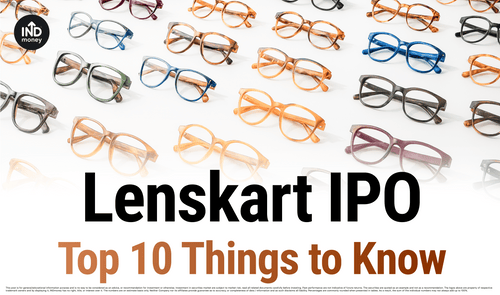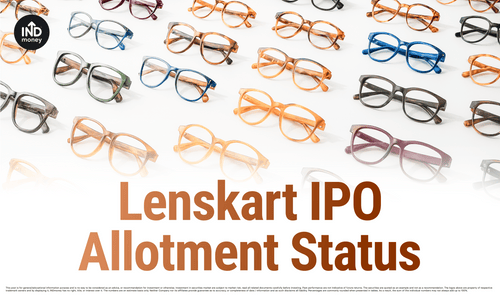
Lenskart IPO
Lenskart IPO Price Range is ₹382 - ₹402, with a minimum investment of ₹14,874 for 37 shares per lot.
Subscription Rate
28.26x
as on 04 Nov 2025, 07:26PM IST
Minimum Investment
₹14,874
/ 37 shares
IPO Status
Price Band
₹382 - ₹402
Bidding Dates
Oct 31, 2025 - Nov 4, 2025
Issue Size
₹7,278.02 Cr
Lot Size
37 shares
Min Investment
₹14,874
Listing Exchange
BSE
IPO Doc
Lenskart IPO Application Timeline




IPO Subscription Status
as on 04 Nov 2025, 07:26PM IST
IPO subscribed over
🚀 28.26x
This IPO has been subscribed by 7.535x in the retail category and 40.346x in the QIB category.
Subscription Rate
| Total Subscription | 28.26x |
| Retail Individual Investors | 7.535x |
| Qualified Institutional Buyers | 40.346x |
| Non Institutional Investors | 18.227x |
Lenskart India IPO: What’s in It for Investors?
Lenskart is one of India’s biggest eyewear brands - from glasses and sunglasses to contact lenses. This short video breaks down how Lenskart makes money, its business model, growth story, and what makes it stand out in the eyewear market. Easy insights for retail investors who want to understand what’s behind the buzz around its IPO.
Objectives of IPO
- The company’s ₹7,278.02 crore IPO is structured as a combination of a fresh issue of equity shares and an offer for sale (OFS) by existing shareholders. The fresh issue is intended to aggregate up to ₹2,150 crore. The OFS involves the sale of up to 12.76 crore equity shares, amounting to ₹5,128.02 crore. It will not receive any proceeds from the offer for sale, as those funds will go entirely to the selling shareholders. These selling shareholders include promoters like Peyush Bansal and Neha Bansal, as well as investor shareholders such as SVF II Lightbulb (Cayman) Limited and Schroders Capital Private Equity Asia Mauritius Limited, among others.
- Out of the total fresh issue, it plans to spend ₹272.62 crore towards capital expenditure for setting up new company owned and company operated (CoCo) stores in India. These funds will be used to open approximately 620 new CoCo stores over the financial years 2026, 2027, 2028, and through November 2028. This capital spending covers store setup costs, including furniture, fittings, and digital equipment.
- It will dedicate ₹591.44 crore towards payments related to lease, rent, or license agreements for its existing CoCo stores operated within India.
- An amount of ₹213.38 crore is allocated for investing in technology and cloud infrastructure. This investment aims to strengthen and scale its end-to-end technology infrastructure, which supports its core omnichannel business model and centralized supply chain.
- It proposes to use ₹320.06 crore for brand marketing and business promotion expenses to enhance brand awareness. For context, its marketing and promotion expenses for the FY25 totaled ₹448.41 crore.
- The remaining amount will be set aside for funding unidentified inorganic acquisitions and general corporate purposes, such as business growth initiatives, working capital funding, and future loan repayments. As of October 13, 2025, its aggregate outstanding borrowings stood at ₹311.39 crore.
Financial Performance of Lenskart
The company has demonstrated a strong financial rebound and consistent operational scaling across the reported periods. Total Income rose steadily from ₹3,928 crore in FY23 to ₹7,009.3 crore in FY25, reflecting a robust expansion, largely driven by increasing demand and growth across its omnichannel network. The increase was further supported by the full-year consolidation of the Owndays acquisition in FY24. Quarterly momentum continued, with total income growing 24.45% year-over-year from ₹1,563.7 crore in Q1 FY25 to ₹1,946.1 crore in Q1 FY26.
Profitability showed a major turnaround. The company reversed losses of ₹63.8 crore in FY23 and ₹10.2 crore in FY24 to report a profit of ₹297.3 crore in FY25. The quarterly performance mirrored this trend, soaring from a loss of ₹11 crore in Q1 FY25 to a profit of ₹61.2 crore in Q1 FY26. This operational shift was validated by the EBITDA Margin, which surged from 6.86% in FY23 to 14.6% in FY25, reaching 17.77% in Q1 FY26. This rise is attributed to improved operating leverage gained through scaling the centralized supply chain and vertical integration.
Balance sheet metrics reflect strategic management. Total Borrowings decreased substantially by 38.6% CAGR between FY23 and FY25, falling to ₹335.5 crore by June 30, 2025. This reduction stemmed primarily from the repayment of long-term debt and payments towards lease liabilities. Total assets increased consistently, reaching ₹10,845.7 crore as of June 30, 2025. This asset growth was driven by continued capital expenditure, particularly additions to property, plant, and equipment and right-of-use assets due to new store openings.
Strengths and Risks
Strengths
It is the only fully integrated retailer globally with a centralized supply chain. This model allows it to achieve an average cost for frames and lenses in India that is 35-40% lower than the industry average for similar quality products.
It is India’s largest organized retailer of prescription eyeglasses by sales volume. Its physical presence totals 2,806 stores globally, giving it a store footprint in India that is approximately 2.5 times larger than its next largest organized rival.
Revenue grew at a 32.5% CAGR from FY23 to FY25. Operating profitability significantly improved, with EBITDA margin (excluding other income or exceptional item) expanding from 6.86% in FY23 to 17.77% in the three months ended June 30, 2025.
New stores demonstrate excellent returns, achieving an average payback period of only 10.29 months across metropolitan and Tier 1/2+ cities as of March 31, 2025. Indian stores also achieved the highest average annual sales of ₹23,492.5 per square foot among organized rivals in FY25.
It utilizes proprietary AI tools like computer vision for store optimization and geo-analytics for new store placement. Customers engaged in 3.86 crore virtual try-ons in FY25, driving efficient digital customer engagement and conversion.
Its loyalty program, Lenskart Gold, boasted 71.2 lakh members in India as of June 30, 2025. New customers acquired in FY23 showed an average purchase frequency of 3.62 eyeglasses within two years, significantly higher than the Indian average of 1.8.
It has substantially reduced its total debt from ₹917.21 crore (March 31, 2023) to ₹335.48 crore (June 30, 2025). This improved its financial stability, reflected by its interest coverage ratio rising from 5.11 times (FY23) to 8.44 times (Q1 FY26).
It efficiently manages its operational cash cycle, as Net Working Capital Days dramatically reduced to 24.08 days in the three months ended June 30, 2025. This shows significant improvement from 34.52 days in FY24.
Risks
The cost of raw materials is high, accounting for 25.45% [₹467.34 crore] of total expenses in the three months ended June 30, 2025. Reliance on materials imported from China (53.38% in Q1 FY26) exposes it to price volatility and geopolitical supply chain disruption risks.
The company’s reliance on its Gurugram industrial cluster facilities (Bhiwadi and Gurugram) creates a concentration risk. As of Q1 FY26, these two sites handled 98.42% of its total owned manufacturing production. Any localized natural disaster or regulatory change could severely interrupt order fulfillment, impacting the highly specialized lens customization process.
Retail operations rely on leased premises, resulting in total lease liabilities of ₹2,399.81 crore as of June 30, 2025. Failure to renew key store leases on favorable terms or unexpected rental spikes could disrupt its operations and affect its financial condition.
The company reported losses in recent financial periods, including ₹63.76 crore in FY23 and ₹10.15 crore in FY24. There is a risk that it may not achieve consistent, positive financial results or cash flows in the future.
Operating in 14 countries subjects it to management, political, and foreign exchange risks. Fluctuations in the Indian Rupee exchange rate could negatively impact operating margins and the valuation of reported overseas assets/liabilities. For context, in Q1 FY26, nearly 39% of its revenue came from the international market.
Total prescription eyeglasses manufacturing capacity utilization across all facilities stood at only 55.10% in the three months ended June 30, 2025. The Gurugram facility was particularly low at 39.22%, signaling potential asset underutilization risk.
How to Apply for Lenskart IPO on INDmoney
- Download the INDmoney app and complete your KYC.
- Go to INDstocks → IPO, or just search “IPO”.
- Tap on Lenskart IPO from the list of live IPOs.
- View key details like price band, lot size, and dates.
- Tap Apply Now and choose your number of lots.
- Use INDpay UPI for instant mandate tracking.
- Your funds will be blocked until the share allotment is finalized.
Listed Competitors of Lenskart
Company | Operating Revenue (₹ Cr) | EBITDA (₹ Cr) | EBITDA Margin |
Lenskart | ₹6,653 Cr | ₹971 Cr | 14.6% |
₹796 Cr | ₹85 Cr | 10.7% |
Lenskart Shareholding Pattern
| Promoters & Promoter Group | 19.85% | |
| Name | Role | Stakeholding |
| Peyush Bansal | Promoter | 10.28% |
| Nehal Bansal | Promoter | 7.61% |
| Amit Chaudhary | Promoter | 0.98% |
| Sumeet Kapahi | Promoter | 0.96% |
| Others | Promoter Group | 0.02% |
| Public | 80.15% | |
| Name | Role | Stakeholding |
| SVF II Lightbulb (Cayman) Limited | Public | 15.03% |
| Platinum Jasmine A 2018 Trust | Public | 12.45% |
| PI Opportunities Fund-II | Public | 5.13% |
| Macritchie Investment Pte. Ltd | Public | 4.86% |
| Unilazer Alternative Ventures LLP | Public | 3.94% |
| Alpha Wave Ventures LP | Public | 3.93% |
| Alpha Wave Ventures II LP | Public | 3.81% |
| Steadview Capital | Public | 3.42% |
| Birdseye View Holdings II Pte. Ltd | Public | 2.2% |
| Dove Investments Limited | Public | 2.06% |
| Kedaara Capital Fund II LLP | Public | 1.97% |
| Jongsong Investments Pte. Ltd | Public | 1.73% |
| Kedaara Capital Fund III LLP | Public | 1.66% |
| Kedaara II Continuation Fund | Public | 1.65% |
| Schroders Capital Private Equity Asia Mauritius | Public | 1.13% |
| Bay Capital Holdings Ltd | Public | 1.09% |
| Others | 14.11% |
About Lenskart
It serves diverse customers through a tiered brand portfolio, including premium (Owndays) and affordable ranges (Vincent Chase). Its key markets are India, Southeast Asia, Japan, and the Middle East. It relies on an omnichannel network encompassing websites, apps (with over 10 downloads), and physical retail. As of June 30, 2025, it operated 2,806 stores worldwide, split between 2,137 stores in India and 669 stores internationally. Its footprint in India is about 2.5 times larger than the next leading organized rival. In FY25, it sold 2.72 crore eyewear units globally, and its Lenskart Gold loyalty program in India had 71.2 lakh members.
The company's unique competitive advantage is its vertically integrated model with a centralized supply chain. This means it maintains full control from product design to manufacturing frames/lenses at its centralized Indian facilities (Bhiwadi, Gurugram) and retailing directly to the consumer. This system achieves significant efficiency, resulting in 35-40% lower average costs for frames and lenses in India compared to the industry average in FY25. Stores primarily function as consultation, eye testing, and ordering centers, simplifying rapid expansion. Moving ahead, its future direction emphasizes expanding its retail presence into all city tiers in India and strengthening operational efficiency through continuous investment in technology, automation, and AI tools.
For more details, visit here: www.lenskart.com
Know more about Lenskart
Top 10 Must-Know Facts Before You Invest in the Lenskart IPO
Discover the most important things to know about the Lenskart IPO, including founder and investor actions, business strengths, risks, and valuation details. Get the full investor guide and expert analysis before deciding to invest.

Lenskart Share Lists at a Discount: Should You Buy, Hold, or Sell?
Explore Lenskart's ₹7,278 Cr IPO listing, valuation insights, promoter share sale, and listing day price action. A clear guide for retail investors on buy, hold, or sell decisions.

Check Lenskart IPO Allotment Status, Latest GMP & Subscription Updates
Check your Lenskart IPO allotment status with the official registrar link. Get the latest GMP trends and know how to verify allotment and the refund timelines.

Frequently Asked Questions of Lenskart IPO
What is the size of the Lenskart IPO?
What is the allotment date of the Lenskart IPO?
What are the open and close dates of the Lenskart IPO?
What is the lot size of Lenskart IPO?
When will my Lenskart IPO order be placed?
Can we invest in Lenskart IPO?
What would be the listing gains on the Lenskart IPO?
What is 'pre-apply' for Lenskart IPO?
Who are the promoters of Lenskart?
The four promoters of the company are Peyush Bansal, Neha Bansal, Amit Chaudhary, and Sumeet Kapahi. They collectively hold 33.42 crore equity shares, representing 19.83% of the company's pre-IPO fully diluted share capital.
Who are the competitors of Lenskart?
Lenskart’s DRHP states that no listed companies in India or globally share its integrated business model. It competes with Indian retailers like Eyegear Optics and Titan Company Limited (Eyecare division). Global competitors include Essilor Luxottica, Fielmann, JINS Holdings, and Warby Parker.
How does Lenskart make money?
It generates revenue primarily from selling eyewear products. Prescription eyeglasses are the largest revenue driver, accounting for more than 80% of its operating revenue in FY25. It also earns fees from memberships (Lenskart Gold) and services.